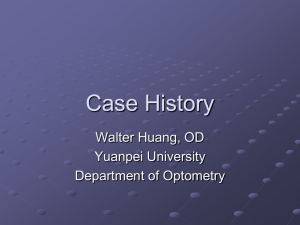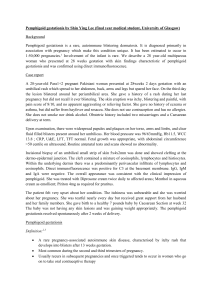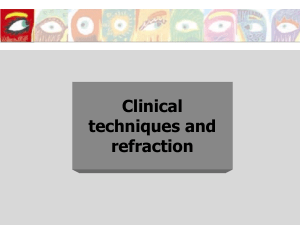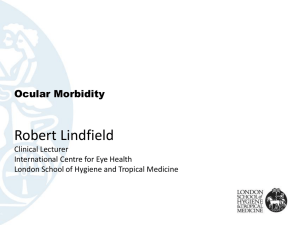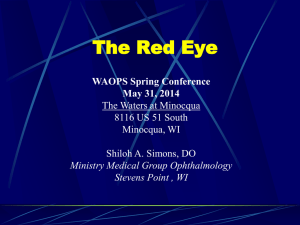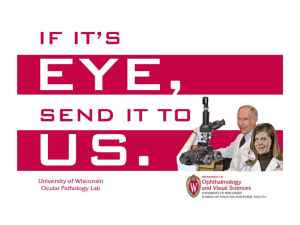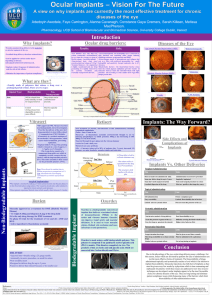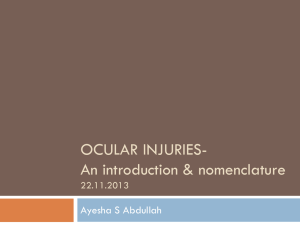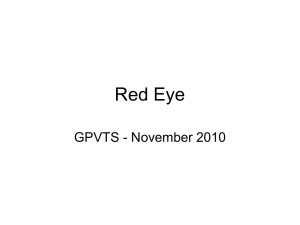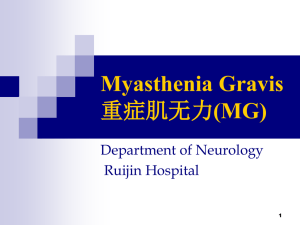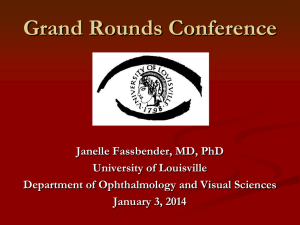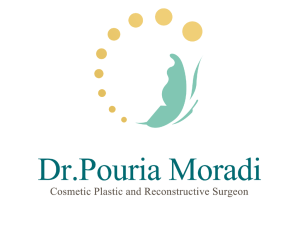Ocular Cicatrial Pemphigoid - University of Louisville Department of
advertisement
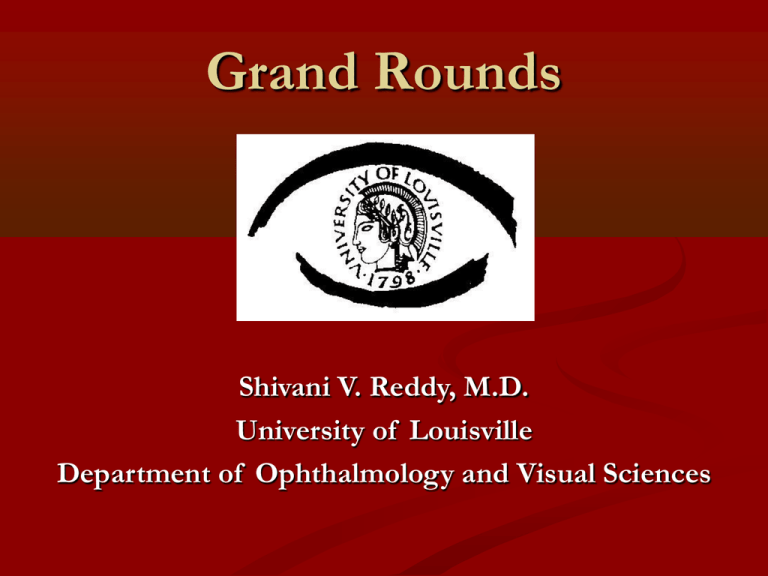
Grand Rounds Shivani V. Reddy, M.D. University of Louisville Department of Ophthalmology and Visual Sciences History CC: “eyelashes turned in” HPI: 72 y/o WM referred to oculoplastics clinic for a progressive trichiasis over 3-4 years. Patient states that growth is much more pronounced in the left eye . Also c/o chronic tearing, irritation and yellowish-white discharge in both eyes, worse on the left. States that overall symptoms have been progressing over about a 5 year span History POHx: Retinal detachment OS 1997, CE + IOL OU PMHx: Bullous Pemphigoid, Peripheral neuropathy, Asthma, Hypothyroidism, HTN FAMHx: noncontributory ROS: joint pain, muscle aches and difficulty swallowing intermittently MEDS: dapsone, zioptan, avodart, bystolic, cymbalta, nexium, b12, synthroid, NKDA Exam 4→3 20/20-1 VA P 20/100+1 (PH: NI) 4→3 + RAPD OS EOM: full OU CVF: superior field limitation OU Anterior Segment OD Lids/Lashes Conj Cornea mild entropion few trichiatic lashes mild injection multiple SPE OS UL+LL entropian trichiasis symblepharon 2+ injection multiple SPE inferonasal corneal erosion Iris WNL WNL Lens PCIOL PCIOL Physical Exam HENT: single tense vesicular lesion on soft palate Thorax: 2 vesicular lesions on upper back Extremities: single vesiculo-bullous lesion on right leg Skin Lesion erupted bullous lesion on the right lower extremity Summary 72 y/o WM presents with trichiasis OU 2/2 entropion, decreased visual acuity OS, symblepharon OS , 2+ conjunctival injection OS with an inferonasal corneal erosion. Dermatologic exam reveals vesicular lesions on the soft palate, upper back and lower extremity DDx: o Autoimmune Cicatricial Conjunctivitis o MMP, Sarcoidosis , SLE, Lichen Planus, IgA dermatosis o Atopic Keratoconjunctivitis o Ocular Rosacea o Chronic Infectious Conjunctivitis o Adenovirus , streptococcus o Pseudopemphigoid (drug-induced ) o Conjunctival Trauma Treatment o Same day: UL + LL epilation OS, aggressive lubrication o OS cicatricial entropion repair + MMG of Upper and lower lid o Pathology results o Acutely inflamed tissue infiltrated with histiocytes, lymphocytes and neutrophils. Subepithelial fibrosis lacking elastic fibers indicative of scarring o Immunofixation not performed One Month Post-Op Visit Grafts healing well, significant inflammation persistent, no residual trichiasis Mucous Membrane Pemphigoid • Group of heterogeneous diseases characterized by inflammatory blistering of the oral, ocular, pharyngeal, laryngeal and genital mucosa • Main pathological feature: linear deposits of IgG, IgA and C3 in the epithelial basement membrane zone • When MMP presents as a chronic scarring conjunctivitis, it is known as Ocular Cicatricial Pemphigoid Ocular Cicatricial Pemphigoid Clinical features o Early on, signs of chronic or relapsing conjunctivitis with vesicles detected on the conjunctiva o Tearing , burning, mucous drainage o Loss of goblet cells o As the disease progresses, conjunctival shrinkage can cause impaired eye movements and lagophthalmos o Lid margin inflammation and scarring trichiasis o Eventually trichiasis and gland loss lead to progressive corneal keratinization and scarring Ocular Cicatricial Pemphigoid Epidemiology o Incidence: 1/8000 – 1/46000 ophthalmic patients o Average age of diagnosis: 60 – 70 years o Female:Male: 1.5:1 – 3:1 o No geographic or racial predilection Ocular Cicatricial Pemphigoid Pathogenesis o Binding of circulating autoantibodies (IgG, IgA, C3 and other complement factors) to the BMZ (lamina lucida of the dermalepidermal junction) o 205 kd β4 peptide of α6β4 integrin most frequent target Why scarring instead of bullae formation? o Autoantibody binding to BMZ secretion of cytokines (TNFa, IL-1, migration inhibiting factor) recruitment of inflammatory cells release of pro-fibrotic cytokines such as TGF-beta and IFN-gamma scarring o Inciting Event unknown Ocular Cicatricial Pemphigoid 4 Stages Stage II – Shortening of the inferior fornix Ocular Cicatricial Pemphigoid 4 Stages Stage III – Symblepharon formation Ocular Cicatricial Pemphigoid 4 Stages Stage IV – End stage disease manifesting as ankyloblepharon, severe sicca syndrome, severe ocular surface keratinization Ocular Cicatricial Pemphigoid Diagnosis o Most cases are caught in stage 2 to 3 and beyond due to the often insidious nature of progression o Diagnosis is based on: o Clinical Features o Tissue Biopsy o Should be performed perilesionally o Conj biopsy best during active disease o Specimen handling is extremely important as using the wrong specimen fixative can lead to false negative results Ocular Cicatricial Pemphigoid Hematoxylin & Eosin Staining o inflammatory infiltrate of variable intensity . Contains neutrophils, macrophages, plasma cells, lymphocytes, and Langerhans cells o Essentially nonspecific Ocular Cicatricial Pemphigoid Direct Immunofluorescence o Characteristic finding : Linear deposition of IgG, IgA, and/or C3 in basement membrane o However, diagnostic sensitivity is only around 50% . Therefore a negative result does not rule out a disease process Ocular Cicatricial Pemphigoid Immunoperoxidase Assay o Performed if immunofluorescence is negative but strong clinic suspicion o Increases sensitivity of testing from 5283%1 1. Power WJ, Neves RA, Rodriguez A, Dutt JE, Foster CS. Increasing the diagnostic yield of conjunctival biopsy in patients with suspected ocular cicatricial pemphigoid. Ophthalmology. 1995;102(8):1158 Ocular Cicatricial Pemphigoid Treatment Mild to Moderate Disease o Dapsone 50 – 200 mg/day for 12 weeks o Important to check labs – hemolytic anemia risk o MTX, mycophenolate, azathioprine can also be used, but more serious side effect profile Severe Disease o Cyclophosphamide +/- Prednisone for 12 months or less o Must beware of leukopenia o Newer Therapies o IVIG o Rituximab Ocular Cicatricial Pemphigoid Treatment Surgical Intervention o Entropion repair o Symblepharon excision o limbal stem cell transplantation, PK, keratoprosthesis Maintainence Measures o Aggressive ocular lubrication o Lid hygiene for infection prevention o Epilation PROGNOSIS? Current literature shows long term remission in 1/3 of patients for an average of 34 months with IM therapy References 1. BSCS Volume 8, External Diseases and Cornea . 2013 2. Pepose,Holland, Wilhelmus. Ocular Infection & Immunity. 1996 3. 1. Power WJ, Neves RA, Rodriguez A, Dutt JE, Foster CS. Increasing the diagnostic yield of conjunctival biopsy in patients with suspected ocular cicatricial pemphigoid. Ophthalmology. 1995;102(8):1158 4. Ahmed M, Zein G, Khawaja F, Foster CS. Ocular cicatricial pemphigoid: pathogenesis, diagnosis and treatment. Prog Retin Eye Res 2004; 23:579. 5.Fleming TE, Korman NJ. Cicatricial pemphigoid. J Am Acad Dermatol 2000; 43:571. 6. Foster CS. Cicatricial pemphigoid. Trans Am Ophthalmol Soc 1986; 84:527. 7. Chan LS, Ahmed AR, Anhalt GJ, et al. The first international consensus on mucous membrane pemphigoid: definition, diagnostic criteria, pathogenic factors, medical treatment, and prognostic indicators. Arch Dermatol 2002; 138:370. 8.Letko E, Bhol K, Foster SC, Ahmed RA. Influence of intravenous immunoglobulin therapy on serum levels of anti-beta 4 antibodies in ocular cicatricial pemphigoid. A correlation with disease activity. A preliminary study. Curr Eye Res 2000; 21:646. 9. 60.Foster CS, Chang PY, Ahmed AR. Combination of rituximab and intravenous immunoglobulin for recalcitrant ocular cicatricial pemphigoid: a preliminary report. Ophthalmology 2010; 117:861. Thank You
